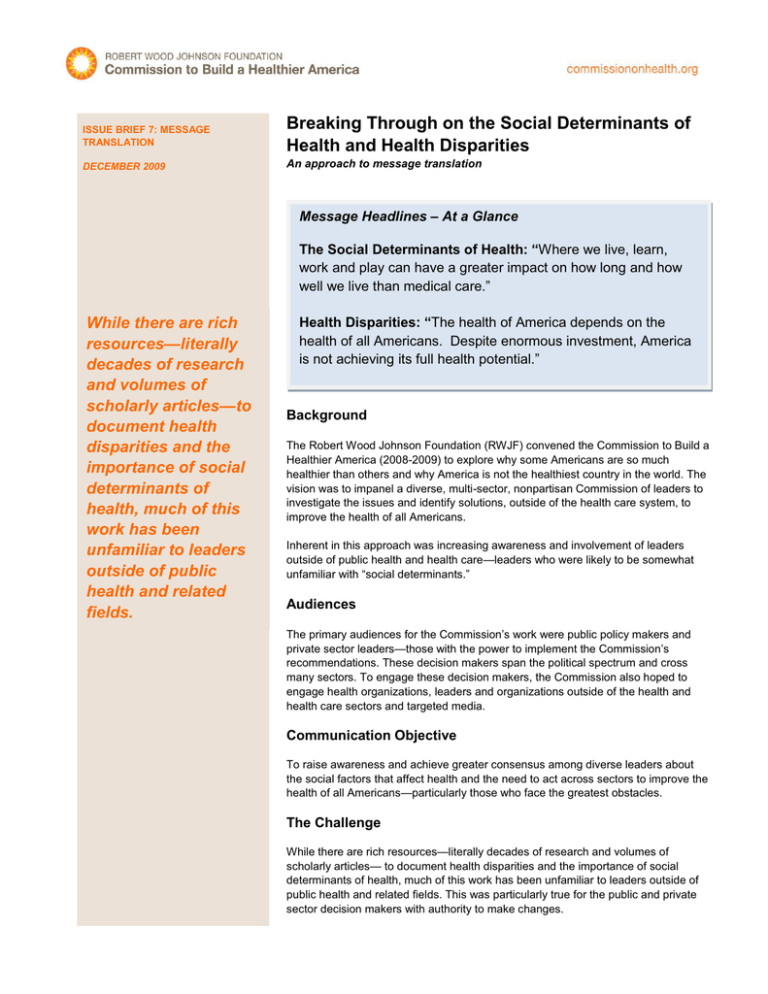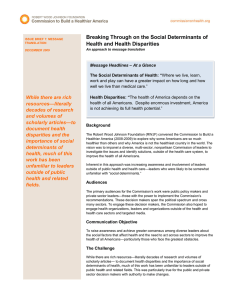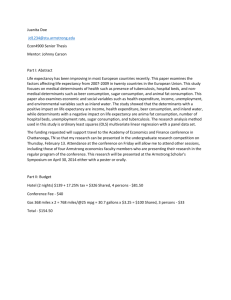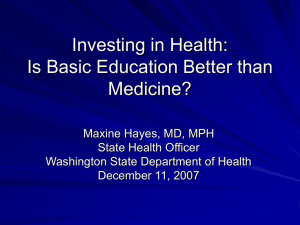Breaking Through on the Social Determinants of Health and Health Disparities
advertisement

ISSUE BRIEF 7: MESSAGE TRANSLATION Breaking Through on the Social Determinants of Health and Health Disparities DECEMBER 2009 An approach to message translation Message Headlines – At a Glance The Social Determinants of Health: “Where we live, learn, work and play can have a greater impact on how long and how well we live than medical care.” While there are rich resources—literally decades of research and volumes of scholarly articles—to document health disparities and the importance of social determinants of health, much of this work has been unfamiliar to leaders outside of public health and related fields. Health Disparities: “The health of America depends on the health of all Americans. Despite enormous investment, America is not achieving its full health potential.” Background The Robert Wood Johnson Foundation (RWJF) convened the Commission to Build a Healthier America (2008-2009) to explore why some Americans are so much healthier than others and why America is not the healthiest country in the world. The vision was to impanel a diverse, multi-sector, nonpartisan Commission of leaders to investigate the issues and identify solutions, outside of the health care system, to improve the health of all Americans. Inherent in this approach was increasing awareness and involvement of leaders outside of public health and health care—leaders who were likely to be somewhat unfamiliar with “social determinants.” Audiences The primary audiences for the Commission’s work were public policy makers and private sector leaders—those with the power to implement the Commission’s recommendations. These decision makers span the political spectrum and cross many sectors. To engage these decision makers, the Commission also hoped to engage health organizations, leaders and organizations outside of the health and health care sectors and targeted media. Communication Objective To raise awareness and achieve greater consensus among diverse leaders about the social factors that affect health and the need to act across sectors to improve the health of all Americans—particularly those who face the greatest obstacles. The Challenge While there are rich resources—literally decades of research and volumes of scholarly articles— to document health disparities and the importance of social determinants of health, much of this work has been unfamiliar to leaders outside of public health and related fields. This was particularly true for the public and private sector decision makers with authority to make changes. Translating any data for a broad audience can be challenging. Translating the wide ranging, highly specific and technical information that characterizes the fields of social determinants and health disparities presented a particularly confounding problem. The complexities were intensified by deeply-held beliefs about the issues that made communicating across a broad spectrum of stakeholders sensitive as well as complex. If the Commission was to accomplish its objectives of reaching, informing and engaging diverse leaders across the political spectrum as a way to make headway on these long-studied issues, it was essential to: 1. Communicate complex information in a way that accurately reflected the research findings in a context that mattered to identified target audiences; and 2. Make the case in a way that appealed to leaders across the political spectrum and connected with leaders both within and outside of the public health and health care communities. Message Development Approach The challenge was to identify how to frame communications in a way that spoke to how people really feel and think about these issues—not just what they openly express. The research-based approach to crafting messages and compelling arguments that would break through to new audiences included: 1. Qualitative Audience Research; 2. Quantitative Audience Research; 3. An Interactive Messaging Workshop; and 4. Development of Stories 1. Qualitative Audience Research to Reveal “Deep Metaphors” The Commission engaged Olson Zaltman Associates (OZA) to gain a better understanding of the target audiences’ thoughts and feelings about differences in health among Americans. The objective was to identify how to frame communications in a way that spoke to how people really feel and think about these issues—not just what they openly express. OZA conducted a series of intense, highly-focused, one-on-one interviews with individuals who represented the Commission’s target audiences, looking for a cluster of “deep metaphors” that would enable the Commission to make fundamental connections with those audiences. According to OZA, these “deep metaphors” reflect the basic structures in our minds that organize our perceptions and shape the sense we make of them and how we react. The feelings around these metaphors are unconscious—an automatic viewing lens that is seldom explicitly acknowledged. Such metaphors are thought to represent fundamental and widely-shared conceptual orientations. Identifying a relevant set of these metaphors would help the Commission craft language and create imagery that connected to the underlying motivations that influence our target audiences’ opinions. Individuals included in these one-on-one interviews were divided into two sets: those who identified themselves as Democrats and those who identified themselves as Republicans. Based on their analysis of information from the interviews, OZA researchers provided recommendations about the three most salient metaphors that seemed to resonate best across these groups. Each of these three metaphors—journey, connection and resources—is described below, along with an example of how the Commission communications team incorporated the metaphor concepts in written and visual communications: Page 2 ! Journey: Journey is often used as a metaphor for life itself, where life is framed as one long journey including many twists and turns. Journey metaphors can be used to convey both the unknown nature of some trips, with unanticipated detours, as well as the predictable outcomes of others, such as knowing that “staying on track” means reaching a pre-set goal or destination. ! The “journey” metaphor was played out in both imagery and words. For example, the cover of the report issued by RWJF to the Commission as it began its work features a photograph of a car driving away down a long road, while the report’s title, “Overcoming Obstacles to Health,” reflects the barriers, or “twists and turns,” that people encounter along life’s journey. ! The Commission also produced a series of maps displaying often dramatic differences in life expectancy within defined geographic areas. Each map incorporated language that referred to the “journey” metaphor—for example, “A short distance to large disparities in health.” ! Connection: Encompassing feelings of belonging or exclusion, connection is reflected in psychological ownership and shows how things are related to one another. Lack of connection is reflected in feelings of distance or separation from others. ! The “connection” metaphor, which can be particularly effective when it draws people’s attention to associations they may not have previously recognized, is reflected in one of the main Commission messages: “Where we live, learn, work and play can have a greater impact on how long and well we live than medical care. In fact, the connections are greater than most of us realize.” ! The Commission also used the “connection” metaphor to communicate the long-lasting impact of social determinants: “Problems that surround people early in life create a chain of events that is often difficult to stop.” ! Resources: Resources are essential to our survival. We require resources such as nutrients and water to live and grow. Our family and friends are resources that support us in tough times. Because many valuable resources are limited, we must use them judiciously. ! The “resources” metaphor—especially wasting resources—played heavily in the Commission’s messaging. The Commission consistently highlighted that “America spends more on health care than any other nation, but we are not the healthiest people” and that “America is not getting good value for its health dollar.” 2. Quantitative Audience Research The Commission also engaged a bipartisan team of polling firms, Public Opinion Strategies and Greenberg Quinlan Rosner Research, to conduct a national survey to gauge registered voters’ perceptions of health differences in the United States. The survey provided a benchmark level of public awareness and identified potential 1 receptivity to changes in public and private sector policies. The survey found: The majority of voters believe health differences due to social factors in this country are an important problem that needs to be addressed. ! 78% agree that “it is important to make sure health differences between groups of people in this country no longer exist because of factors such as income and education.” 1. A complete report of this survey can be found on the Commission’s Web site at: http://www.commissiononhealth.org/PDF/14a4f32d-73e8-4f85-820c5a10acf0b022/Commission%20Media%20Kit.pdf Page 3 In addition to personal behavior, voters view social factors such as income, education and environment as having significant impacts on a person’s health. ! 82% believe living in a safe neighborhood can have a positive influence on a person’s health. ! 67% believe a higher educational level can have a positive influence on a person’s health. ! 68% believe a lower income can have a negative influence on a person’s health. The majority of voters believe government should do more to address health differences in this country due to social factors such as income, education, and environment. ! 60% believe current government policies are not working to reduce health differences. Three clusters of messages collectively created the Commission’s storyline: - Documenting the problem of health disparities - Describing the important role of social determinants in health - Conveying the Commission’s call to action 3. Interactive Messaging Workshop With the findings and insights gathered through the qualitative and quantitative research, along with key health disparities and social determinants research findings, the Commission’s communications team led an interactive messaging workshop with staff experts to craft the Commission’s messaging framework. The Commission’s messaging framework followed a time-tested communications formula to: ! Gain and maintain message control when communicating the Commission’s purpose and activities; ! Tell a clear, compelling story about social determinants of health and health disparities that would matter to key audiences; and ! Frame the issue in a way that would sway and engage target audiences. Three clusters of messages collectively created the Commission’s overarching narrative: documenting the problem of health disparities in America, describing the important role of social determinants in health, and conveying the Commission’s call to action. Considerations for Message Framing How do we make the information clear and compelling without oversimplifying decades of research? Headline what’s most important. How do we break through to gain attention? Challenge conventional wisdom with unexpected facts. How do we make theories tangible? Use real stories, analogies and everyday language. How do we connect with a target audience? Utilize the identified deep metaphors. How do we make it timely and relevant? Provide a call to action. Page 4 Results: Commission Messages, At a Glance Included here is a sample of the Commission’s key messaging, using language rooted in its research. (The complete set of facts and supporting content is not included here.) Theme One: The Problem of Health Disparities in America “Why Your Zip Code May Be More Important to Your Health Than Your Genetic Code” - The Huffington Post, April 29, 2009 The health of America depends on the health of all Americans. Despite enormous investment, America is not achieving its full health potential. ! America spends more on health care than any other nation, but ranks below many countries on key health indicators like infant mortality and life expectancy. ! All Americans do not have the same opportunities to make healthy choices. Sometimes, barriers to healthier decisions are too high for an individual to overcome – even with great motivation. ! Good health requires individuals to make responsible personal choices and requires a societal commitment to remove the obstacles preventing too many Americans from making healthy decisions. Theme Two: The Importance of the Social Determinants of Health Where we live, learn, work and play can have a greater impact on how long and well we live than medical care. ! Our zip code may be more important to our health than our genetic code. ! A person’s health and chances of becoming sick and dying early are greatly influenced by powerful social factors such as education, income, nutrition, housing and neighborhoods. ! There is more to health than health care. Theme Three: The Commission’s Call to Action The Commission to Build a Healthier America will look beyond medical care for ways to improve the health of all Americans. ! Health care reform is essential, but improving the health of all Americans requires broadening our view beyond medical care. ! We must find ways to enable more people to lead healthy lives and avoid getting sick in the first place. Page 5 4. Story Development – Putting a Face on the Issues In addition to the core message points, and as a way to bring the issues and messages to life, the Commission developed a series of human interest stories to illustrate health disparities and how social factors influence health. The stories showcased how nonmedical interventions—school-based programs, workplace programs, nutrition and physical activity programs—have had a positive impact on an individual’s or a family’s health. These stories provided content for story booklets, videos, the Web site, imagery for reports and presentations by Commissioners and RWJF spokespersons. th Kenyon McGriff, Philadelphia: As a 10 grader weighing 270 pounds, Kenyon knew that his neighborhood’s fast food restaurants, corner markets and dimly lit sidewalks challenged his health. An after-school running program helped Kenyon make healthier food and physical activity choices with good results. The repetition of messages supported a consistent and cumulative narrative. Abang Ojullu, Worthington, Minn.: Abang’s young daughter experienced a major improvement in her severe asthma when the family moved to a renovated apartment with air conditioning, exhaust fans in the kitchen and bathrooms, and no mold. Abang says a checkup by the nurse after the move found that her daughter’s lung capacity had noticeably improved. Putting the Messages to Work A key to success was the discipline required to ensure that the Commission, including staff and Commissioners, used the messages consistently across all communications to reinforce the Commission’s main themes with target audiences. The core messages, imagery and stories were used as appropriate in publications, events, media outreach, stakeholder outreach, Web site content and presentations. The repetition of messages allowed the Commission to communicate a consistent and cumulative story. Conclusion The Commission’s purposeful messaging approach—guided by market research and public health research findings as well as communications principles and a creative content development process—helped the Commission craft a focused messaging framework. The process was central to success and worth the upfront investment given the challenges the Commission faced in advancing a sensitive and complex set of issues among diverse decision makers from across the political spectrum. The messages were used by Commissioners representing different sectors and points of view. Given the potential for particular issues related to social determinants and health disparities to have divided Commissioners, this acceptance was an important accomplishment—and a measure of success for how the topics were positioned. Page 6 APPENDIX From Research Findings to Message Points: Examples of Message Translation This chart provides examples of the kinds of more technical research findings that were restated for public consumption in the Commission’s messaging. Research Findings If SES effects are due to poverty and its correlates, one would expect to find a threshold effect above which SES would show little or no association with health outcomes. Studies at both the individual and aggregate levels challenge this expectation. An association of SES and mortality occurs throughout the SES hierarchy. Commission Messages At all income levels, our health falls short of what it could be. (Adler NE, Boyce WT, Chesney MA, et al. "Socioeconomic Inequalities in Health. No Easy Solution." The Journal of the American Medical Association, 269(24): 3140-5, 1993.) Through a combination of latent effects and pathways of living, child development affects health, well-being, and competence throughout the life cycle. (Hertzman C and Wiens M. "Child Development and Long-Term Outcomes: A Population Health Perspective and Summary of Successful Interventions." Social Science & Medicine, 43(7): 1083-95, 1996.) Area-based measures of poverty and deprivation have been found to be associated with health outcomes after adjustment for individual-level factors. Additional studies have suggested that neighborhood-level variables may also shape the distribution of health-related behaviors, although other studies have found little evidence of area effects. (Diez-Roux AV. “Bringing Context Back into Epidemiology: Variables and Fallacies in Multilevel Analysis.” American Journal of Public Health, 88(2):216-22, 1998) When health risk behaviors were considered, the risk of dying was still significantly elevated for the lowest-income group (hazard rate ratio, 2.77; 95% CI, 1.74-4.42) and the middle-income group (hazard rate ratio, 2.14; 95% CI, 1.38-3.25)…Although reducing the prevalence of health risk behaviors in low-income populations is an important public health goal, socioeconomic differences in mortality are due to a wider array of factors and, therefore, would persist even with improved health behaviors among the disadvantaged. The early years of life set us on paths leading toward – or away from – good health. Where we live, learn, work and play can have a greater impact on how long and well we live than medical care. Our zip code may be more important to our health than our genetic code. A person’s health and chances of becoming sick and dying early are greatly influenced by powerful social factors such as education, income, housing and neighborhoods. (Lantz PM, House JS, Lepkowski JM, et al. "Socioeconomic Factors, Health Behaviors, and Mortality: Results from a Nationally Representative Prospective Study of US Adults." The Journal of the American Medical Association, 279(21):1703-1708, 1998.) Page 7 Research Findings Compared with babies born to the most-educated mothers (those with at least 16 years of schooling), infant mortality rates were higher—by as much as 12 deaths per 1,000 live births—for babies born to the least-educated mothers (those with less than 12 years of completed schooling). With few exceptions, infant mortality rates also were higher—by up to five deaths per 1,000 live births—among babies born to mothers in the second highest education group (those with 13-15 years of completed schooling). Compared with children in higher-income families, children in poor, near-poor or middle-income families were 4.7, 2.8 and 1.5 times as likely to be in less than optimal health. Even among children in higher-income families, the percent of children with less than optimal health in almost every state exceeded the national benchmark—3.5 percent—which should be attainable. Commission Messages There are substantial shortfalls in the health of children based on their families’ income and education. Children in the poorest and leasteducated households suffer the worst health outcomes. Even middle class children and children in the best-off families are not as healthy as they could be. (Egerter S, Braveman P, Pamuk E, et al. America's Health Starts with Healthy Children: How Do States Compare? Washington, DC: Robert Wood Johnson Foundation Commission to Build a Healthier America, 2008. Available at www.commissiononhealth.org.) Throughout this century, average life expectancy for all persons in the United States has been increasing… but data show that during 1979–89, 45-year-olds with the highest incomes could expect to live 3 to 7 years longer than those with the lowest incomes. (Pamuk E, Makuc D, Keck K, et al. Health, United States, 1998 with Socioeconomic Status and Health Chartbook. Hyattsville, MD: National Center for Health Statistics, 1998.) A 1998 study revealed dramatic disparities in life expectancy across U.S. counties overall, and particularly when racial or ethnic differences were also considered. For example, black men in the county with the shortest life expectancy for blacks lived only 58 years (well below average life expectancy in many developing nations), while white men in the county with the longest life expectancy for whites could expect to live to age 78—two decades longer. (Braveman P and Egerter S. Overcoming Obstacles to Health. Washington, DC: Robert Wood Johnson Foundation Commission to Build a Healthier America, 2008. Available at www.commissiononhealth.org.) Health shortfalls are even more dramatic when considering the level of adult health that should be attainable. At every level of education in every racial or ethnic group, the percentage of adults 1 in less than very good health exceeds the national benchmark. In the overall population, observed patterns were clearly consistent with a socioeconomic gradient in life expectancy at age 25, health status, and activity limitation due to chronic disease; for these indicators, better health outcomes were seen at each higher level of income or education and the confidence intervals did not 2 overlap. 1. (Egerter S, Braveman P, Cubbin C, et al. Reaching America’s Health Potential: A State-by-State Look at Adult Health. Washington, DC: Robert Wood Johnson Foundation Commission to Build a Healthier America, 2009. Available at www.commissiononhealth.org.) 2. (Braveman P, Cubbin C, Egerter S, et al. “Socioeconomic disparities in health in the United States: What do the patterns tell us?” American Journal of Public Health. In press.) While America has seen great gains in improving health overall, some Americans face much poorer prospects for good health and long life than others. Some Americans will die 20 years earlier than others who live just a short distance away because of differences in education, income, race, ethnicity and where and how they live. Americans at every income and education level should be healthier. Many people with incomes and education above the national average die prematurely from preventable health problems. And for those with limited incomes and education, health outcomes are far worse. Page 8 About the Robert Wood Johnson Foundation The Robert Wood Johnson Foundation focuses on the pressing health and health care issues facing our country. As the nation's largest philanthropy devoted exclusively to improving the health and health care of all Americans, the Foundation works with a diverse group of organizations and individuals to identify solutions and achieve comprehensive, meaningful and timely change. For more than 35 years the Foundation has brought experience, commitment, and a rigorous, balanced approach to the problems that affect the health and health care of those it serves. When it comes to helping Americans lead healthier lives and get the care they need, the Foundation expects to make a difference in your lifetime. About the Commission to Build a Healthier America The Robert Wood Johnson Foundation Commission to Build a Healthier America is a national, independent, non-partisan group of leaders formed in February 2008 to raise visibility of the many factors that influence health, examine innovative interventions that are making a real difference at the local level and in the private sector, and identify specific, feasible steps to improve Americans’ health. The Commission released its recommendations on April 2, 2009. Resources on the Commission Web Site: The Commission’s Web site—commissiononhealth.org—includes a variety of examples of how the messaging was used, along with supporting resources including reports, issue briefs, state-level child and adult health data, fact sheets, multimedia personal stories, downloadable charts, polling results and blogs. Credits Lead Authors Elaine Arkin, Robert Wood Johnson Foundation Danielle DeForge, Chandler Chicco Agency Allison May Rosen, Chandler Chicco Agency Photography Courtesy of the Robert Wood Johnson Foundation Design and Layout Alex Field, Burness Communications Page 9



